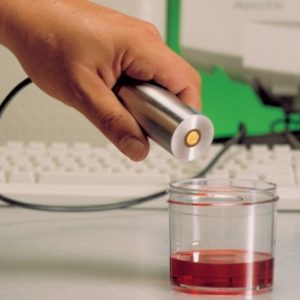The DT-1202 combines both instruments, the acoustic attenuation spectrometer DT-100 and the elecotracoustic probe DT-300 in one device. Thus it is able to measure simultaneously particle size distribution and zeta potential of a liquid, concentrated dispersions in its original state without any modification like dilution!
To calculate the particle size distribution, the DT-1202 is measuring the sound speed and the attenuation of short ultrasound pulses for a set of frequencies, typically from 1 to 100 MHz (“transmission pulse technique” or “tone burst method”). The data will be recorded at different gaps between ultrasound sender and detector to improve the accuracy of the signals. Due to the wide frequency range of this unique technique, very small (< 100 nm) as well as coarse particles (>> 10 µm) can be measured with a high precision. The variable gap between sender and detector enables the characterization of diluted (< 1 vol.-%) and concentrated (up to 50 vol.-%) dispersions. The WINDOWS-bases software take into account the different ultrasound-wave-particle interactions as scattering, viscous losses and thermodynamic effects.


Zeta probe
Additionally, the DT-1202 is analyzing the zeta potential of a dispersion using its electroacoustic probe. Further colloidal parameters can be calculated like Debye-length, κa-value, Dukhin’sche number and surface charge density in case of strong non-polar solvents. Due to the smart design of the probe (pulse-echo method, smooth surface) it can be easily used both for laboratory experiments and for process-near online measurements.
/1/ ISO 20998-1 Measurement and characterization of particles by acoustic methods.
/2/ ISO 13099-3 Colloidal systems – Methods for zeta potential determination.
/3/ A. Dukhin, P. Goetz: Characterization of Liquids, Nano- and Microparticulates, and Porous Bodies using Ultrasound. 2nd Edition. Oxford: Elsevier, 2010.
/4/ PARTICLE WORLD 19; p. 18 – 19; “Characterization of liquids, dispersions, emulsions and porous materials using ultrasound”.
This software-controlled unit is designed to enable the particle size and zeta potential measurement independent of the pH or the amount of an additive. The system can be programmed to carry out automatically different types of protocols (dosing amount of additive/acid/base, pH-value and time).
This option consists of a stirrer, a heavy-duty stand and a vessel made of special glass. The sample volume and stirrer design prevent funneling of the sample below the probe, allowing accurate measurements.
Two different probes are available to measure the electric conductivity. Both are fully integrated in the DT-software:
The probe for measurements in organic solvents is also available as a separate device: DT-700.
| DT-100/ DT-110 | Acoustic attenuation spectroscopy 5 nm – 1000 µm |
| Bettersizer S3 series | Static light scattering and dynamic image analysis 0.01 – 3500 µm |
| Bettersizer 2600 | Static light scattering 0.02 – 2600 µm |
| BeNano series | Dynamic Light Scattering 0.3 nm – 15 µm |
| BeVision D2 | Dynamic image analysis 2 µm – 10000 µm |